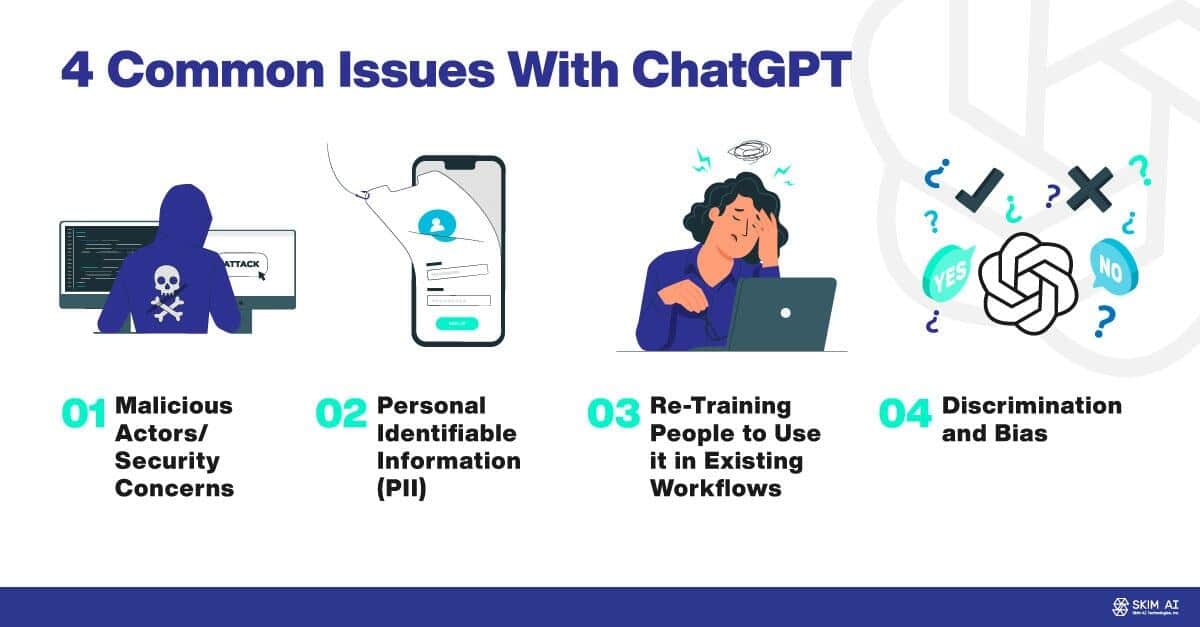Common Issues With ChatGPT and How to Mitigate Them
Common Issues With ChatGPT and How to Mitigate Them
ChatGPT is a generative ai chatbot that has been trained to engage in human-like conversation with users. This technology has seen a surge in popularity as more and more organizations and individuals seek to leverage the benefits of AI chatbots, such as improved customer service, increased efficiency, and reduced costs. However, despite the many benefits of using ChatGPT, there are also some common concerns that arise when utilizing it.
Some of the most common issues that arise with ChatGPT, and those that everyone should be aware of, include: malicious actors/security concerns, personal identifiable information, re-training people to use it, and discrimination/bias.
Let’s take a deeper look at each one of these and how they can be mitigated.

[Infographic]
**Malicious Actors/Security Concerns**
Security is a critical concern when it comes to ChatGPT, as malicious actors can exploit the chatbot to gain unauthorized access to sensitive information or write and spread malware. Hackers can create fake ChatGPT chatbots that appear to be genuine and use them to trick users into revealing confidential information such as login credentials, financial information, or personal details.
Denial-of-service (DoS) attacks are another significant security risk for ChatGPT. These attacks aim to disrupt the normal functioning of a website or service by overwhelming it with traffic from multiple sources. In the case of ChatGPT, a DoS attack could result in the chatbot being unavailable for users, thereby impacting the user experience and potentially causing reputational damage.
To mitigate some of these risks, proper security protocols should be in place when implementing ChatGPT. These protocols may include using encryption for data transfer, implementing two-factor authentication for accessing the chatbot, and regularly monitoring for any unusual activity.
In addition to these measures, it’s also important to educate users on best practices for interacting with ChatGPT. Users should be aware of the risks of sharing personal or sensitive information with the chatbot and should know how to identify and report any suspicious activity. By taking a proactive approach to security and implementing appropriate measures, organizations and individuals can minimize the risk of security incidents with ChatGPT.
**Personal Identifiable Information (PII)**
The collection of personal identifiable information (PII) is a significant concern when it comes to ChatGPT. Chatbots often collect information such as name, email address, and location, which can be sensitive and cause concern for users. If this information is not handled correctly, it can lead to privacy violations, identity theft, and other forms of data misuse.
When applicable, it’s essential that your chatbot is compliant with relevant data protection regulations, such as the General Data Protection Regulation (GDPR) or the California Consumer Privacy Act (CCPA). The GDPR is a European Union regulation that provides guidelines for the collection, processing, and storage of personal data. Even if an organization is not based in the EU, it may still need to comply with GDPR regulations if it collects data from EU citizens.
A clear privacy policy is also essential for users to understand how their data will be collected, stored, and used. The policy should outline the types of data that will be collected, who will have access to the data, and how the data will be secured. It’s important to be transparent with users and ensure that they understand how their data is being used.
It’s also crucial to limit the data collected to only what is necessary for the chatbot’s function. Chatbots should only collect data that is relevant to the conversation and not collect additional data that may be used for other purposes. For example, a chatbot for a retail store may only need to collect a user’s name and email address to send them a coupon code, and it would not be necessary to collect additional information such as their phone number or home address.
**Re-Training People to Use it in Existing Workflows**
Introducing ChatGPT into an organization can be challenging because it may not always fit seamlessly into existing workflows. Employees may be used to interacting with customers or clients in a particular way, and introducing a new technology can disrupt these established processes.
To ensure that ChatGPT is used effectively, it’s essential to provide training for employees on how to interact with the chatbot. This can include how to phrase questions to get the best response from the chatbot, what types of questions the chatbot can answer, and how to escalate more complex issues to a human representative.
Providing employees with training on how to use ChatGPT effectively can help to minimize frustration and ensure that the technology is used correctly. It can also help to increase employee confidence in the technology, which can lead to greater adoption and more significant benefits for the organization.
It’s also important to ensure that the chatbot is integrated into existing workflows in a way that makes sense for the organization. For example, if ChatGPT is being used for customer service, it should be integrated into the organization’s customer service process and escalation procedures. This can help to ensure that the chatbot is used effectively and that customer issues are addressed in a timely and appropriate manner.
**Discrimination and Bias**
The potential for bias and discrimination is a significant concern when it comes to ChatGPT. Chatbots may be trained on biased datasets, which can lead to discriminatory responses to certain groups of people. This issue is especially concerning as AI chatbots are increasingly being used in areas such as recruitment and hiring, where discrimination can have serious consequences.
To mitigate the risk of bias and discrimination, it’s essential to ensure that the dataset used to train the chatbot is diverse and representative of the population it will be interacting with. This means including data from a variety of sources and ensuring that the dataset is balanced in terms of gender, race, age, and other factors. It’s important to use data that reflects the diversity of the intended user base to ensure that the chatbot’s responses are inclusive and do not discriminate against any particular group.
Having mechanisms in place to identify and correct bias or discriminatory responses is also critical. This can include regular monitoring of the chatbot’s responses and identifying any patterns of bias or discrimination. It’s important to have a process in place for correcting any issues and ensuring that the chatbot’s responses are inclusive and respectful of all users.
The organization should also have diverse teams of individuals involved in the development and training of the chatbot. This can help to identify potential biases and ensure that the chatbot is developed in a way that is inclusive. By involving people with diverse backgrounds and perspectives in the development process, organizations can ensure that the chatbot is developed with sensitivity to potential biases and discrimination.
****Powerful But Potentially Problematic****
ChatGPT is a powerful tool that can offer numerous benefits to organizations and individuals. However, it’s essential to be aware of some common issues that may arise when using this technology.
Security is a significant concern, and it’s essential to ensure that proper security protocols are in place to mitigate the risk of malicious attacks or data breaches. Collecting PPI is another critical issue that requires careful handling to protect user privacy.
Introducing ChatGPT into an organization can also present challenges, and it’s important to provide training to employees to ensure that the chatbot is used effectively and integrated into existing workflows.
The potential for bias and discrimination is a critical concern that requires careful attention. By ensuring that the chatbot is trained on diverse and representative datasets and has mechanisms in place to identify and correct any biases or discriminatory responses, organizations can ensure that their chatbot is inclusive and respectful of all users.
Despite these challenges, ChatGPT remains a powerful tool that can offer numerous benefits. By being aware of these common issues and taking steps to mitigate them, organizations and individuals can leverage the power of ChatGPT while ensuring the privacy and security of users and promoting inclusivity and respect.






